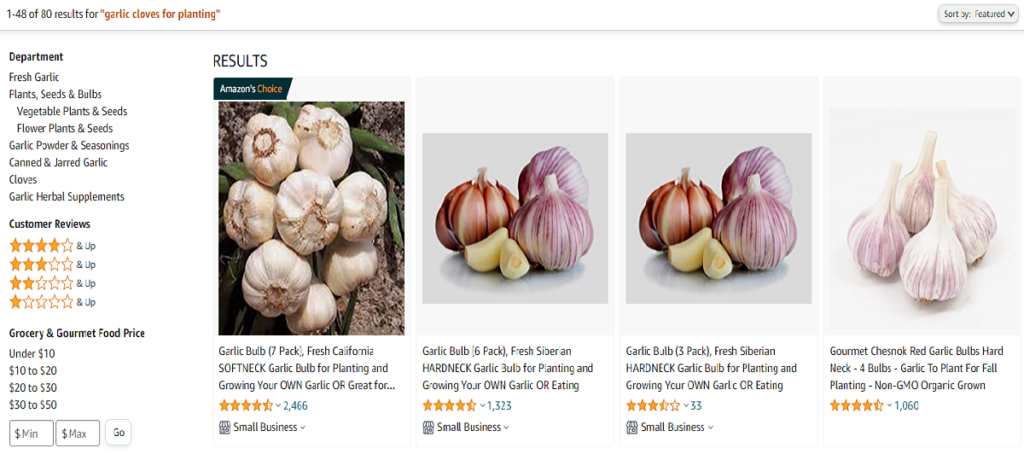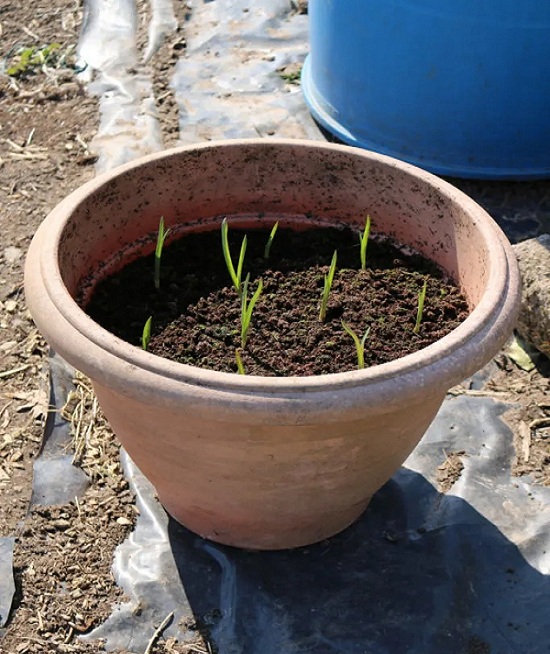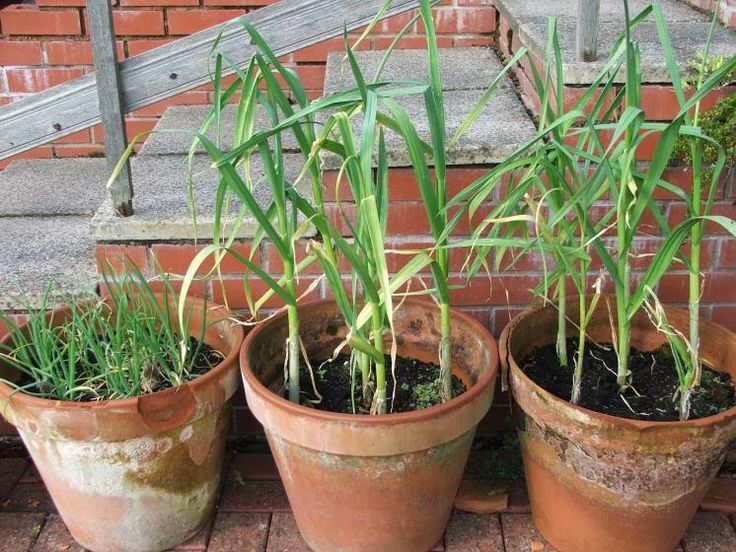Garlic is a useful crop even before it has been harvested. A wide variety of pest species are put off or distracted by this plant, making it a great choice for a companion.
Garlic and other edible crops need a lot of room to grow, but not everyone has access to acres upon acres of land. The good news is that garlic can be grown just about anywhere, in containers or pots.
How to Choose the Right Garlic
Choosing the best garlic variety for your climate is the first step to growing garlic successfully in containers.
The two most common kinds of garlic bulbs are hardneck and softneck sets.
All the way through the middle of a hardneck bulb is a long flowering stem (the scape). Softnecks have more cloves because they lack a stem. There are instances where a single bulb will produce more than 30 cloves, but typically 8-20 is the average.
As a general rule, hardneck varieties are the best choice for gardeners in cooler climates. If you want to get more garlic scapes out of your garden, you should grow hardneck varieties.
Soft-neck cultivars lack the ability to produce scapes. In contrast, softneck garlic has a longer storage life and is more suitable for gardeners in warmer climates.

Sourcing Garlic Cloves For Planting
Garlic cloves purchased at the supermarket should not be planted immediately. It’s possible that a growth inhibitor has been sprayed on these cloves to keep them from sprouting.
Instead, you should go to a gardening store, nursery, or online to find some cloves to plant.

Picking Your Pot
In terms of containers, you can pick from a wide variety. Suitable planters and pots can be purchased commercially. Another option is to recycle or repurpose something already in your possession.
Pot Size
When selecting a pot or container, remember that it should be at least 6 inches deep. Better yet, it’d be a bit deeper. The ideal planting depth for garlic cloves is 2 inches.
There should be about 3–4 inches of space between garlic cloves in your container. (A little further apart if it’s a variety with especially large bulbs.) You can typically plant up to 16 cloves in a planter or container with a 1 square foot surface area.
Material & Characteristics
The growing medium needs to be kept moist, but the container should still drain well. Make sure there are drain holes in the base of the 5 gallon bucket (or whatever container you’re reusing) so that the contents don’t get waterlogged.
You should always keep in mind that your container’s qualities will be determined by the material it was made from. Plastic storage containers, in comparison to terracotta ones, tend to hold onto moisture a little bit longer. Rather than using plastic containers, you should use terracotta pots. However, keep in mind that you will likely need to water them more often. Potted garlic does not like soggy soil. However, you shouldn’t let it get too wet either.
Container Color
Your choice of container or pot color is also important. There will be more heat absorption and retention in containers that are black or dark in color. Where lighter colors absorb less heat from the sun and thus remain cooler. Depending on the weather, one of these choices may not be suitable for your needs. And when and where you’ll plant garlic.

Choosing the Appropriate Growing Medium
Make sure the soil or other growing medium is rich in nutrients and relatively fertile. Growing garlic successfully calls for a good, relatively fertile soil; however, moisture and drainage are of utmost importance.
Adding some homemade compost to a good, free-draining potting mix should do the trick. A small amount of grit or sand added to a denser, less porous potting mix can help prevent the medium from becoming too wet.
Garlic cloves should be planted upright in their growing medium (taking care not to damage the cloves’ bases) and then mulched heavily to keep the soil moist and promote growth.
A high-quality organic mulch can prevent water loss and keep weeds at bay. Additional nutrients can be added gradually. Additionally, in cold climates, is essential for keeping the garlic’s roots warm over the winter. Leaves from the autumn are perfect for this. Certainly other materials could be used as well, such as straw, bracken, etc.

When To Plant Garlic
Planting garlic in the spring or fall is ideal.
Planting in the fall is recommended for regions with colder winters because it gives plants time to establish deep roots before the first freeze, and it gives the new growth of spring foliage a head start.
Depending on when the first frost occurs in your region, garlic should be planted between the months of September and early November. Fall-planted garlic in containers is typically ready to pick in late June.
Note: Mulch is crucial for providing plant protection during the colder months and early spring in northern latitudes. Young garlic shoots are killed by temperatures below 20 degrees Fahrenheit (-6 degrees Celsius).
It’s best to get a head start on spring planting:
- Zones 5-6: Sow sets -individual cloves- for summer (Around March/April).
- Zones 7-8: Sow sets for summer in February.
- Zones 9-10: Sow sets for summer around January/ early February.
Naturally, garlic planted in the spring won’t be ready for harvesting until late in the summer.

Where to Put Potted Garlic
The location you decide on for your planters or vases is crucial.
Consider sun, shade, watering points, and kitchen proximity. If you live in a colder climate and plan on sowing seeds in the fall, it’s important to find a sunny, protected spot to set your container(s). Garlic can be grown successfully in partial shade, reducing summer watering needs in hotter climates.
Locating your garden’s containers near a water supply will make maintaining them much simpler (whether that is an outside faucet, or a rainwater harvesting system). Setting up a garlic patch close to the kitchen can also speed up prep time.
Garlic, when grown in pots near other fruits and vegetables grown in containers, can serve as a natural pest deterrent. Due to its potent odor, garlic can be a good companion crop even when grown in a separate container nearby.

Garlic Maintenance
It is critical to keep the soil moist but not wet when watering. Once a bulb has formed, plants need thorough watering every three to five days. Cut watering two weeks before harvest.
The scapes of hardneck garlic varieties can be harvested and eaten as they develop. This will not only increase the edible yield. It will also aid in channeling the energy into bulb formation.
Applying a nitrogen-rich fertilizer as a top dressing or drenching the soil in the spring can be beneficial. Keep the soil around your garlic free of weeds, as the plants can’t handle the extra competition.

Garlic Companion Plants
Growing garlic in containers is a fascinating prospect because it is not necessary to grow each plant individually. Containers (if sufficiently large) can be used to grow multiple plant species at once, just like a bed or in-ground growing area.
In the same pot as your carrots, for instance, garlic will thrive. Even in colder climate zones, certain types of carrots and other root crops can be grown over the winter with garlic planted in the fall by covering them with a cloche or some other form of protection.
It’s also important to think about time and space layers when cultivating plants. In temperate zones, garlic planted in the fall will spend the winter establishing its root system but won’t sprout until the following spring.
To make use of the space in the container before the garlic needs it, you might plant a hardy winter crop like lettuce or Asian greens. The use of a cloche is obligatory in regions with harsher winters. Don’t forget to add nutrients before spring arrives so the garlic can grow.
While you wait for your garlic cloves to sprout, you could plant some lettuce.
Growing a few garlic cloves in a container alongside something else is another option. As was previously mentioned, garlic pairs well with a wide variety of fresh produce. It might be a good option to plant in the spring in a container that will later house a tomato plant or peppers.

Harvesting Garlic
It’s not always simple to tell when garlic is ready to be harvested, and there are a few things you should do in the weeks leading up to the big day to successfully get there.
Take a look at our guide to harvesting, curing and storing your homegrown garlic so it lasts for eight months or more.
Learn How to Grow Garlic This Fall!

